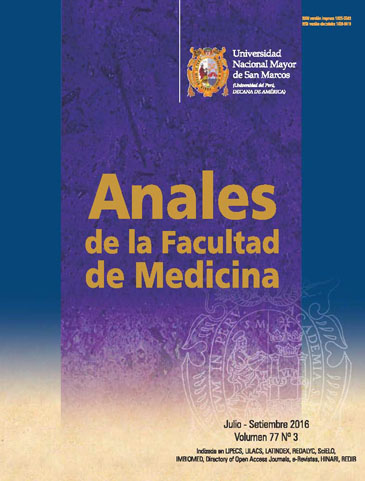Peruvian household dietary diversity in children between 6 to 35 months
DOI:
https://doi.org/10.15381/anales.v77i3.12402Keywords:
Diet, Nutritional Quality, Complementary Feeding, Child, Peru.Abstract
Introduction. Household dietary diversity is key element in the quality of the diet in children. Objective. To estimate household dietary diversity and chronic malnutrition (CM) in Peruvian children. Design. A cross-sectional study was conducted during 2012-2013. Setting. National Institute of Health, Lima, Peru. Participants. Children between 6 to 35 months living in Peruvian households. Interventions. Probabilistic, stratified and multistage sampling. The sample included 13 216 households with 1 315 children. Dietary diversity (DD) was defined as 4-7 intake of food groups during the previous day by the World Health Organization (WHO) standard. An analysis of complex samples was made in SPSS and the weighting factor was adjusted. Percentages, chi square and OR were calculated. Written informed consent of the parents was requested. Main outcome measures. Dietary diversity. Results. 75.5% of children received from 4 to more food groups. Children (78.5%) had higher frequency of DD than girls (72.5%). Children living in urban areas had increased DD. Poor children had high DD (80.2%). Meat consumption was fourth in the order of most foods consumed by children. The DD was associated with the DC (p> 0.05). Age 6-11 was protective factor of DC. The girls, rural areas, children living in the mountains, jungle, the primary education level, poverty were associated with DC. Conclusions. Three quarters of Peruvian children age 6-35 months had adequate household dietary diversity. The DD was associated with CM although the association was not significant.Downloads
Published
2016-10-12
Issue
Section
Artículo Original
License
Copyright (c) 2016 Carolina Tarqui Mamani, Doris Alvarez Dongo, Guillermo Gómez Guizado, Silvia Rosales Pimentel

This work is licensed under a Creative Commons Attribution-NonCommercial-ShareAlike 4.0 International License.
Those authors who have publications with this magazine accept the following terms:
- Authors will retain their copyrights and guarantee the journal the right of first publication of their work, which will be simultaneously subject to Creative Commons Attribution License that allows third parties to share the work as long as its author and its first publication this magazine are indicated.
- Authors may adopt other non-exclusive licensing agreements for the distribution of the version of the published work (eg, deposit it in an institutional electronic file or publish it in a monographic volume) provided that the initial publication in this magazine is indicated.
- Authors are allowed and recommended to disseminate their work over the Internet (eg: in institutional telematic archives or on their website) before and during the submission process, which It can produce interesting exchanges and increase quotes from the published work. (See El efecto del acceso abierto ).
How to Cite
1.
Tarqui Mamani C, Alvarez Dongo D, Gómez Guizado G, Rosales Pimentel S. Peruvian household dietary diversity in children between 6 to 35 months. An Fac med [Internet]. 2016 Oct. 12 [cited 2025 Jun. 6];77(3):219-24. Available from: https://revistasinvestigacion.unmsm.edu.pe/index.php/anales/article/view/12402



